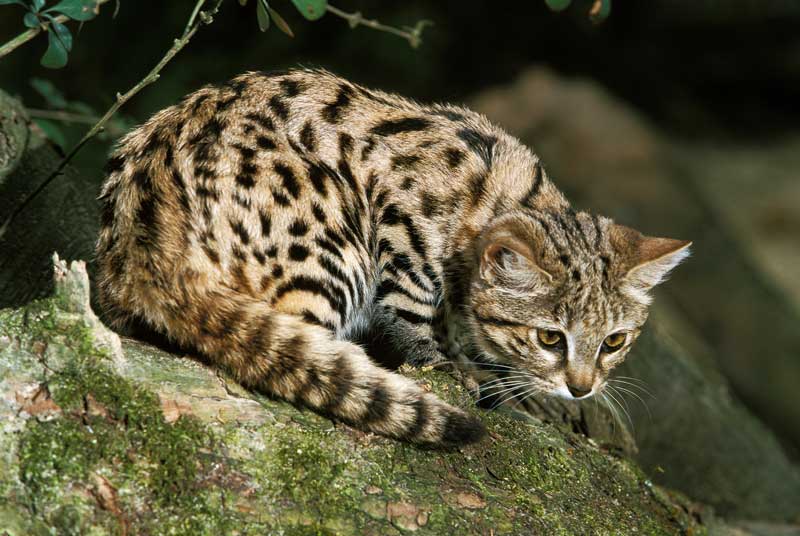|
Yes, I'm STILL featuring obscure wild cats...
Did you know the black-footed cat is Africa's smallest wild cat? Weighing only 2.2 to 5 pounds (1 to 2.4 kg), these tiny cats look similar to domestic house cats, though they are only half the size of house cats. These cats may be small, but they are amazingly fierce and energetic hunters, often walking over 22 miles (35 km) in a single night in search of prey. Biologists who have studied these cats consider them to be the deadliest cats in the world, with a success rate of 60%, meaning they successfully catch and kill 60% of the prey animals they pursue. Lions have a success rate of only 20 to 25%. As one scientist stated, "In one night, a black-footed cat kills between 10 and 14 rodents or small birds, averaging a kill about every 50 minutes." Where these cats live in South Africa they are often called miershooptier, which is Afrikaans for "anthill tiger." They get this name because, during the day, they often rest in hollow termite and ant mounds.
0 Comments
Still looking at interesting wild cats.
Did you know the ASIAN GOLDEN CAT is called the fire tiger in Thailand? Legend has it that, if a village burns some of this cat's fur, it will drive tigers away from the village. Some people believe that carrying around a single hair from an Asian golden cat will keep tigers away. Asian golden cats, which have beautiful white markings on their faces, live in Southeast Asia and China. These cats are most closely related to the bay cat and the marbled cat, two additional species that many people have never heard of. In China, people mistakingly assume these cats are a type of leopard, and they sometimes call it a yellow leopard. Asian golden cats can have many different shades of fur, which has resulted in a variety of other names. Those with black fur are inky leopards, and those with spotted fur are sesame leopards. Still looking at interesting wild cats!
Did you know the cat called the jaguarundi is so elongated that it is often called the otter cat? These cats, only slightly larger than the average domestic cat, weighing 7.7 to 15.5 pounds (3.5 to 7 kg), have extremely long necks, small ears, elongated bodies, and long tails. They're just all-around long! Jaguarundis live from southern Mexico, through Central America, into South America. Although much smaller, they are most closely related to the puma (also known as the mountain lion or cougar). Jaguarundis are mostly active during the day, and they hunt a variety of small animals. In spite of their small size, these cats have been observed jumping up to two meters (6.7 feet) in the air to catch birds. Although jaguarundis usually live alone, they have an impressive range of 13 different vocalizations for communicating with other individuals. They are good climbers and swimmers, but they prefer hunting on the ground. Continuing with the theme of Ridiculously Cute Wild Cats...
A few days ago I posted about the fishing cat. Speaking of cats that eat fish, did you know the FLAT-HEADED CAT, which is smaller than an average domestic house cat, also specializes in catching fish? It even has extra-long, backward-curving teeth to help it hold on to slippery, wriggling fish. Flat-headed cats get their name from having an unusually flattened forehead and tiny ears. They have very short legs, and a tail that's only half the length of an average domestic cat's tail. One of the smallest wild cats, flat-headed cats weigh only 3.3 to 5.5 pounds (1.5 to 2.5 kg). An endangered species, the flat-headed cat lives in the Thai-Malay Peninsula, Borneo, and Sumatra. These cats probably deserve the name fishing cat even more than the actual fishing cat that already has that name. Flat-headed cats eat fish almost exclusively, though they occasionally catch frogs and crustaceans. Flat-headed cats lunge into the water after their prey. When they catch a fish, they first wash it off in the water to get rid of the sand and dirt, then they carry it a few meters from the water's edge to eat it, which prevents the fish from escaping back into the water. Continuing the theme of RIDICULOUSLY CUTE WILD CATS.
Did you know the fishing cat of Southeast Asia is an excellent swimmer and is talented at catching fish? We tend to think that cats, in general, hate water, but that's not true for some cat species. The fishing cat loves water and is adapted to catching aquatic prey. They have partial webbing between their toes, and their claws do not fully retract, which helps them grab hold of slippery prey animals underwater. They also have two layers of fur, one dense layer that makes a water barrier, and a longer layer that provides the cat's spotted, camouflage appearance. Fishing cats weigh from 11 to 37 pounds (5 to 17 kg). These cats are nocturnal and shy, so there is much about them we don't know. However, we do know they like to stand at the water's edge and swipe at fish and other aquatic animals that swim by, piercing them with their claws and then snapping them up in their jaws. Sometimes they even launch themselves headfirst into the deeper water when fish swim by farther from the shore. They eat a lot of fish this way (75% of their diet is fish), but they also eat rodents, birds, snakes, lizards, frogs, clams, snails, and insects. Fishing cats have even been observed swimming underwater so they can grab ducks by the legs from below. |
Stan's Cogitations
Everyone needs a creative outlet. That's why I write. Archives
July 2024
|






 RSS Feed
RSS Feed